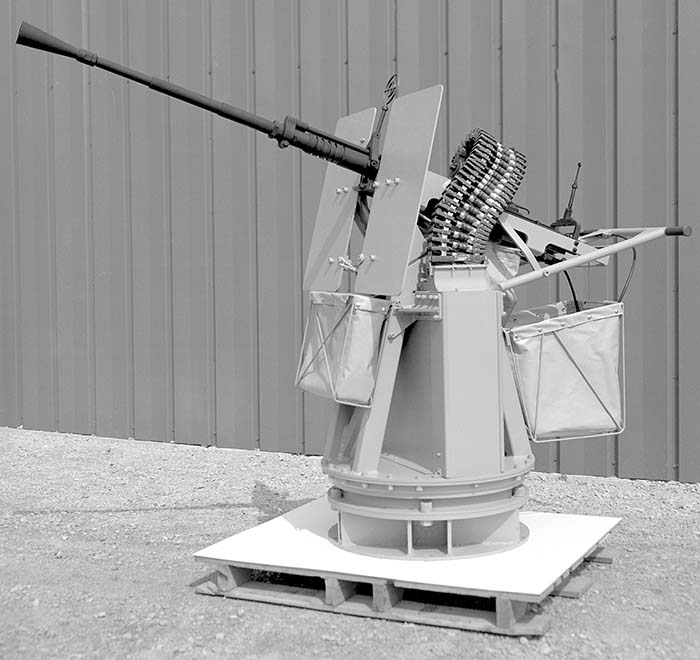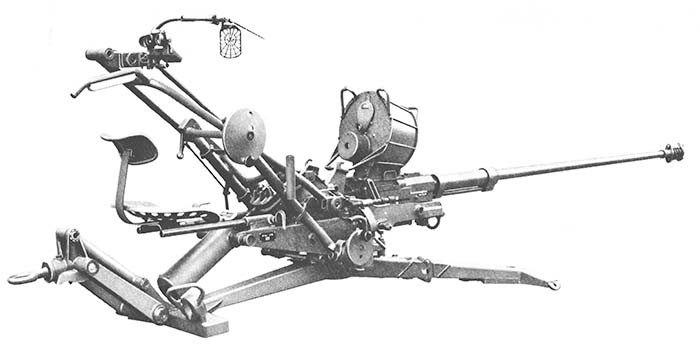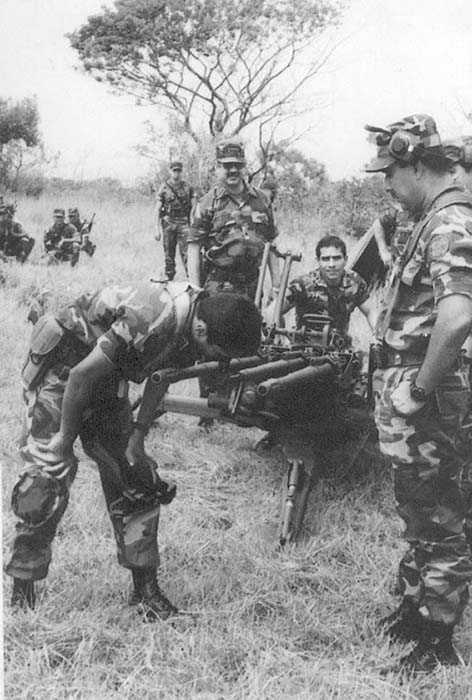M114/M55A2 SP at the National Guard HQ. (J.Montes)
By Julio A.Montes
On a South American TV station, there was a preview of “El Golpe,” a Spanish documentary from the History Channel on the Argentinean Coup of the 70s. A wheeled gun truck was shown supporting troops storming an installation. Although the footage suggested that the vehicle was part of the Argentinean Army, the shot wasactually a self-propelled M55A2 system of the Salvadoran National Guard during the conflict in that country, and certainly not a participant of the Argentinean coup.
There have been few tracked vehicles in service with the armed forces of El Salvador. The first tracked armored vehicles acquired by the Salvadoran military consisted of a handful of CV-33 Ansaldos acquired in Italy around 1937, which oddly enough ended up in the hands of the National Police after a failed coup against General Maximiliano Hernández Martínez. These were followed by eight M3A1s supplied as part of Lend-Lease by the US in 1944, which continued to operate well into the 1970s. In 1978, the Salvadoran Army purchased 27 Woodmaster tractors in Augusta, Georgia, using funds from the Agricultural Ministry. These were no other than discontinued M114 vehicles stripped of plates. Upon arrival to the Santo Tomas Port in Guatemala they were immediately escorted to the Armed Forces Workshop (Maestranza) in El Salvador, where 23 were later rebuilt into armored personnel transports. Although the new armored body provided much needed protection, the mechanical defects of the M114 “tractors” remained. These included an unreliable and breaking-down prone Chevrolet V8 gasoline engine of 160hp, and poor traction. Within a year, Maestranza had adapted the LDT-465IC diesel V6 of 140hp engines from the M35 trucks. This improved range but reduced maximum speed to some 50km/h. Nevertheless, the vehicles easily overheated, and this confined them to be used as reaction tools rather than their intended field supportive role.

When Maestranza started to rebuild the M114 tractors it concentrated in three basictypes. The initial tracked transport variant presented a simple box-like structure; even American advisers often confused this variant for modified M113. The gun carrier variant appeared more like a WWI tank, sporting several machine gun turrets or pedestals. Finally, the utility/ cargo variants sported an open bed and were used for diverse roles, including one modified as an amphibious assault/patrol vehicle.

Yugoslavian M55A2 Systems
In the early 1970s, the Army acquired some 32 M55A2 anti-aircraft gun systems, and distributed them between units around the country. Ilopango AFB received 12 M55A2 systems, but only one battery (with six pieces) was ever operational under the local control of the base Security Battalion. The M55A2 is basically the former Hispano-Suiza (HS) 630 mount, consisting of three 20mm HS-804 cannons mounted on a two wheeled undercarriage built under license from Switzerland by the Federal Supply Bureau Yugoslavia. The weapon weighs 970 kg when in firing position (without ammunition), and 1,110kg in traveling mode (with ammunition), and each gun is fed by a drum type magazine with 60-rounds. Rate of fire is claimed to be 700 rpm per gun, with an effective range of 1,200 meters in the anti-aircraft role. The maximum horizontal range is 5,500m, and the maximum vertical range is 4,000m. Although the system can fire from the traveling position, the usual method of employment is with the wheels raised from the ground and the system resting on a tripod. Elevation is accomplished by rotating a small disk located in front of the gunner’s seat; maximum elevation is +83 degrees with a minimum depression of -5 degrees. This capacity proved vital during the civil war since the system was employed against guerrilla attacks, and not against the intended air threat. A fireselector (single-automatic) is conveniently located under the gunner’s seat. The guns can traverse 360 degrees, but it would be difficult to keep track of a high velocity, low-level target. Traverse is accomplished by rotating a crank on the left side of the gunner’s seat.

The Self Propelled Gun Carrier is Born
By 1978, Captain Oswaldo Marenco had developed a gun truck based on an International Harvester dump truck for the National Guard. This was later used to field the first M55A2 self-propelled system, and this was the system featured in the History Channel piece on Argentina over 28 years later. Marenco designed a simple box-like turret where a cage with two side plates welded and linked at the top by an overhead plate replaced the wheels from the undercarriage, and access to the turret was made possible through two small doors immediately behind of the gunner’s seat. The manual operations of the system remained unchanged, and the turret could rotate 360 degrees, but no provisions were made for optical sights or any other electronic or electrical assistance.
As the turret developed by Marenco allowed the standard M55A2 tripod to remain intact, when the time came to accommodate the weapon into the M114 utility/cargo this was accomplished simply by depressing the tripod legs to accommodate them into “hooks” inside the vehicle’s main body. Four tracked selfpropelled M114/M55A2s are known to have been built: Model-10012 was delivered to the Treasury Police, and later to Ilopango AFB, and Model-10016 to the National Guard.
In the late 1970s, officers of the 3rd Infantry Brigade requested the conversion of one of their MAN 630 trucks to a M55A2 self-propelled armored system. A larger turret was developed providing more protection than the previous designsand, in theory, the guns could be loaded from inside the cramped space of the turret. A pair of 90mm M67 RCLs were placed on top of the turret and were synchronized to the HS-804 cannons. The 20mm were actually used as spotting “rifles” for the RCLs. The HS-804 cannons could not be elevated more than +25 degrees. The system was later reported with the 5th Infantry Brigade.
Modernization is the Key
The M55A2 is a manually operated system. Although powerful, it cannot deal properly against even older generation fighters at low level. Nevertheless, there are advanced, computer and powered assisted variants of the M55 developed in Yugoslavia that could be used as a model to improve and modernize the Salvadoran pieces.

Such is the case of the M55A3B1, which uses the PANS-20/3 sight, good to engage air and ground targets. The sight helps to engage targets at a maximum range of 1,500m, moving at speeds up to 1,000 km/h. The M55A3 model has powered elevation and traverse provided by a 6kW petrol Wankel engine. This engine is mounted on the traversing mass alongside the gunner gunlayer. The M55A4B1 variant is even more advanced, with the Wankel engine moved beneath the gunner’s seat. The sight is a hydraulic servomechanism computing J171, which is basically an Italian-designed P- 56 model, allowing engagement of ground and air targets at a horizontal range of 2,500m. It is also feasible that the M55A2 system can be upgraded using Swiss GAIDO1 components.
Another alternative for the Salvadorans could consist in converting the triple mounts to lighter, single gun models, using components of the Yugoslavian M75/ 1, or the equivalent Oerlikon-Contraves GAI-BO1 model. An M-75/1 model equipped with a M73 reflex sight is a costeffective air defense and fire support weapon that can be easily accommodated on flat bed pickups such as the Humvee M1097.
French HS-404 Cannons
At the end of the war, the Salvadoran Armed Forces had at least 30 HS-404 20mm guns in storage. The cannons come from retired Ouragan planes since each fighter was equipped with four weapons. Although the fighters are no longer in service, the cannons can still be very useful. Lt. Col. Vicente Bolaños from the Cavalry Regiment indicated in early 1998 that a Cashuat had been modified as suggested, and in 1999, the Cavalry Regiment presented an upgraded Cashuat light armored vehicle equipped with a pintle-mounted HS- 404 cannon.

(CCP via von Santos)
Furthermore, it has been demonstrated that the Salvadoran technicians posses the knowhow to develop a simple powered turret that could accommodate the gunner and firing mechanism for the gun. In the fighter-model, the cannon was belt fed, and linked to an ammunition box with 125 rounds. This same installation can be modified for mounting on a small turret, similar – at least in concept – to that opentopped model found in the German Wiesel AFV. Another example could be the older Swedish Hägglund and Söner HS-20 turret that mounted a HS-404 cannon in a cylindrical lightly armored encasement. Right: “New” AAA piece completed with HS404 cannons recycled from obsolete Ouragan fighter. (CCP via von Santos) The one-man turret was equipped with several periscopes, and a monocular sight of 8x magnification, along with an M18 external open sight for aerial engagements. A machine gun pod was provided later. The turrets could be mounted on the surviving UR-416 armored vehicles.
The HS-404 can be used to replace or complement the M29 cannons used by the Salvadoran Navy as well. For now, the sailors have developed a mount – based on the Mk-68 models – to adapt two MGs. The same pedestal could accommodate the HS-404 on patrol boats or on flatbed vehicles (Cashuat AFV or similar).
Around 2002, Maestranza developed a manually operated air defense piece with two of the HS-404 cannons, and an undercarriage inspired on the M55A2 model. However, a major technical problem remained with the high rate of fire of the HS404. Finally, in 2005, a technical officer from Maestranza was able to overcomethe drawback, and the cycle of fire was reduced to a more appropriate rate for use against ground targets, and a battery of 6 double-gun pieces was finally fielded. In 2006, the successful development of the Salvadoran twin 20mm gun system inspired a newer, power operated, AAA piece housed in an armored tub. The powered assisted turret is lightly armored and open-topped. The system was then mounted on an elderly 6×6 M809 fiveton truck, modified with an armored body and a redesigned forward armored cabin (much similar to the M977). This new Mad-Max style self propelled system then was successfully field-tested, and is now ready for service. It was later verified that four machines have been assembled and ready…If only the US could supply the M977 with armored kit…
It is not clear whether the new AAA systems are able to properly track air targets since the joystick has to be perfectly synchronized to follow it rather than depending on high-speed of traverse and elevation for shooting. I believe that a better mounting to take inspiration from was the TCM-20 mount, which also uses the HS- 404 guns. Even today, the US could supply M41/M55 Quad .50 caliber multiple machine gun mount systems from Vietnam stocks (if there are still some leftover somewhere) to accommodate the HS-404 in place of the machine guns. These can be easily be accommodated on the Cashuat armored vehicle for something similar to the M16 half-track ADA system of WWII or more recent M3/ TCM20, and able to be used against ground targets and air targets while providing limited protection for the crew, gunner and ammunition. A Cashuat equipped with this weapon could be deployed for convoy escort, perimeter defense, airport defense, mobile air defense, and infantry support vehicle.
The self-propelled systems allowed the gunner to fire the weapon without exposing himself and under the protection of the turret. The main drawback was that once the 180 rounds of ready ammunition were used-up, the crew had to load the guns in the open. They were used mainly for perimeter and convoy security since the awesome firepower of the HS- 804 cannons could easily overwhelm any guerrilla attack. However, the Army failed to take advantage of this firepower and failed to develop an appropriate doctrine and tactics to use them. Today, the Salvadoran Army lacks any ADA self-propelled system since the International Harvester gun truck was dismantled in 1988, and the modified M114 and MAN truck were retired from service in 1992.
During the battle of Najaf in mid 2004, a Salvadoran patrol was trapped until it ran out of ammunition; after much pleading to their Spanish HQ, four BMR/VECs were dispatched to help, arriving just on time to find the trapped Salvadoran unit engaged in a hand-to-hand struggle for their lives. The incident highlighted the need for counting on its own armored support. It is important to remember that out of all our allies in Latin America, the Salvadorans are the only ones that have retained soldiers in Iraq, fighting side-byside with our US forces. Salvadoran troops in Iraq have finally been equipped with several M1114 up-armored vehicles for in-theater operations. Salvadoran Cuscatlán Battalion soldiers in Iraq have been recipients of US medals for valor when defending US officials, and they have sustained casualties in the process. However, the promised 24 M1114 by the US to be delivered to the Cavalry Regiment back home have not materialized in 2007.
The Salvadoran Army deploys two gun trucks built at local workshops that are basically useless for anything other than parades. The upcoming platoon of four gun trucks being built now on the M809 trucks chassis and HS-404 guns will provide considerable firepower in a low-level conflict as long as the proper tactics and doctrines are developed for their use. Until the formal introduction of the “new” self-propelled systems, the four tracked and two wheeled M55A2 ADA systems deployed between 1979 and 1992, remain as the most powerful support vehicles ever assembled in El Salvador.
| This article first appeared in Small Arms Review V11N2 (November 2007) |











